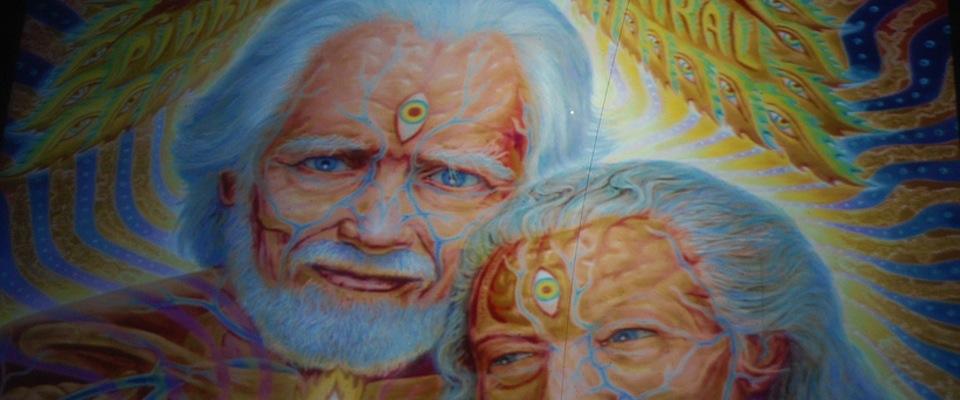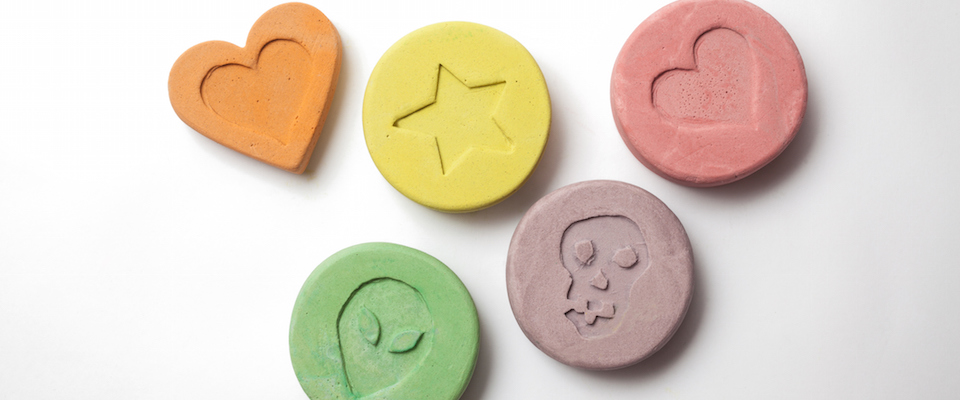Update: The federal government has just given special permission to a team of Marin County therapists to study whether the party drug Molly or Ecstasy—both street names for the illegal psychoactive drug MDMA—is able to reduce anxiety in people with life-threatening illnesses. (Experts caution that much of the contraban sold as Ecstasy now is mixed with other dangerous substances.) The new willingness to investigative MDMA’s therapeutic potential would have been welcome news to the man credited with synthesizing it for psychiatric use in the 1970s: Alexander Shulgin, who held a Ph.D. in biochemistry from UC Berkeley and died one year ago: June 2, 2014.
They came by the hundreds to Berkeley this past weekend to pay their respects to the man they called Sasha—the Berkeley-bred chemist nicknamed the Godfather of Psychedelics. Alexander “Sasha” Shulgin, a controversial iconoclast who pioneered the use of psychedelics for self discovery and synthesized MDMA (commonly known as Ecstasy) in the 1970s and some 200 variations in his lifetime, died of cancer at age 88.
“He was the first scientist who was a chemist, who worked at Berkeley, who had impeccable credentials, and yet he believed what I believed,” said an attendee known as Mr. Natural, himself the subject of a 1960s counterculture comic. Confined to a wheelchair, Mr. Natural took BART for the first time in 30 years Saturday to attend the public memorial for his old friend. Traveling from San Francisco’s Haight Ashbury neighborhood—where the elderly music teacher/artist/scientist spends most of his time—he joined the throng filling the seats at the Berkeley Community Theater.
“Use them with respect as to the transformations they can achieve, and you have an extraordinary research tool.”
“Sasha’s work is by all objective criteria worthy of the very highest academic honors, Nobel Prize kind of stuff, but such honors are impossible as we struggle as a society to learn how to balance the complexities that are stirred up by the power of psychedelics,” said UC Berkeley neurobiology lecturer David Presti during the hour-long memorial service. “It was too big to be done in a multimillion dollar laboratory. It instead required an alchemist’s den, a courageous spirit, a careful focus of intention, and a goodly dose of mystical insight. Then the stuff of legend happened. Thank you, Sasha.”
The turnout included scientists and artists, professionals and idlers, the young and the old. Some dressed to the nines, others in shorts, sandals and socks. Many long haired, most grey-haired. All personally touched by Shulgin’s work.
“Today I am a vice president at Google. Thirty years ago, I was a kid in the Midwest who knew there must be something more,” said Bradley Horowitz, one of the speakers. He said his journey began with psychedelic chemistry. “When I think of Sasha’s work, I think not only of the brilliant chemistry but also the contribution in legitimizing these experiences, making them supported, shedding the stigma, shedding the misunderstanding of society and making them open and available to people who are genuinely curious and want to know who they are. So on behalf of one kid in the Midwest and all of us who know, thank you.”

For years, Shulgin’s work was isolated to his backyard laboratory. He once had a strong relationship with the Drug Enforcement Administration, often assisting with drug trials and providing expertise on the subject. But that changed when his compounds moved from the laboratory to the rave party scene in the 1980s. Reports of bad reactions, fatal overdoses and negative long-term health effects fueled political outcry. Some critics blamed Shulgin.
In 1986, U.S. authorities classified Ecstasy as a Schedule 1 drug, which has “no currently accepted medical use and a high potential for abuse.” The DEA cut all ties with Shulgin. The biochemist spent the rest of his life defending his compounds, publishing countless papers about their therapeutic effects. He remained a dichotomous figure. The New York Times described him as “both a rogue and a wizard, a legitimate scientist and a counterculture hero.” The Guardian wrote: “It was not Shulgin’s intention to launch a global drug culture, nor to have that compound consumed with such abandon by millions of people. But it was his connection with this drug that made him a folk hero for the counterculture, known as the “godfather of ecstasy”, and a folk devil for many outside it.”
Shulgin cautioned about the repercussions of psychedelics. “Use them with respect as to the transformations they can achieve, and you have an extraordinary research tool,” he wrote. “Go banging about with a psychedelic drug for a Saturday night turn-on, and you can get into a really bad place.”
Family friends, colleagues and kin painted a picture of a hero, a savior. Shulgin applied science to develop a deeper sense of spirituality. He spent his life seeking truth. Shulgin’s research assistant, Tania Manning, explained how he taught her to “make friends with my shadow.” The message from Ricci and Jack Coddington, who traveled from Hawaii to attend the service: “We are forever grateful. Mahalo.” Scott Bodarky compared the late chemist to Socrates and Galileo, calling him the last Renaissance man, a “citizen scientist working in a shed out in the yard fueled by his curiosity, the love of the truth.”
Mr. Natural also remembers him as having a dirty old boy’s humor. The oft-smiling Shulgin “really liked double-entendre and triple-entendres and if it bordered on the edge of something sexy, that was even better,” he recalled. He loved puns, palindromes, limericks and wordplays.
Mariavittoria Mangini remembered one of his favorite jokes, about Gandhi, who walked barefoot, ate very little and suffered from bad breath. “This made him a super calloused fragile mystic hexed by halitosis,” she delivered the punchline, which elicited a roar of laughter from the audience—a reaction generated less from the bad pun itself than from the nostalgia for his sense of mirth.
But most of all, Shulgin loved his Ann, his second wife, with whom he shared the latter half of his life. Together they wrote PIHKAL: A Chemical Love Story, an autobiography/psychedelic recipe book. Several speeches mentioned Shulgin’s everlasting love for his wife, noting how he would walk out to greet her every time she arrived home.
After the ceremony, Ann sat at the center of a courtyard gazebo from which white linen blew in the wind. She was surrounded by her children, grandchildren and close family friends, while guests feasted on a potluck. Melodies from a duo of sitars wafted through the air. Inside there was a traditional tea service.

Shulgin’s work has always combined spirituality and science. Mr. Natural sees it as combining the old world and the new world; he recounted how Shulgin would seek out shamans and witch doctors to see if the drug he synthesized matched one that they had been using for centuries. Where many chemists might look down on “soft” scientists such as psychiatrists, Shulgin insisted hard and soft science went hand in hand.
He is credited with introducing MDMA to psychologists in the late 1970s. John Harrison, an addiction treatment specialist from San Diego and Shulgin memorial volunteer, said he sometimes uses psychedelics in his practice. “Some people think it’s snake oil,” he explained before the service, “but it’s in you.”
The memorial’s participants noted that although Shulgin was no longer with them, he would be be forever be immortalized in his compounds.
“It breaks my heart that we’re missing him now, but somehow it seems that Sasha Shulgin is now tripping in the cosmos somewhere,” said Paul Daley, a research chemist at UC Berkeley who worked closely with Shulgin. “Somehow I also have the feeling that I’ll be running into him again. I’ll probably recognize him in whatever form he’s taking, so I just want to let Sasha know, I’m keeping my eye out.”





















